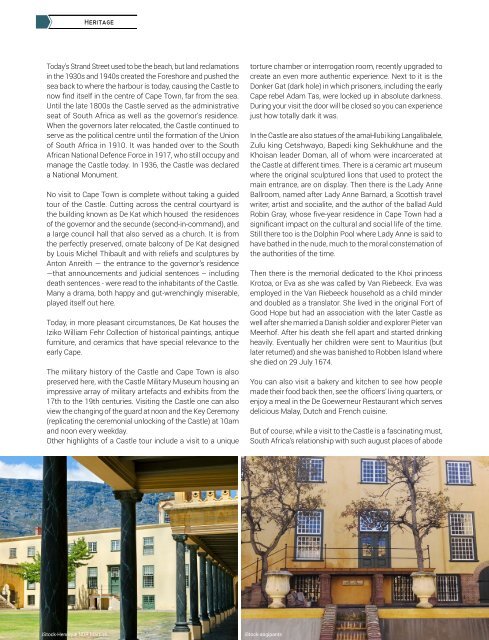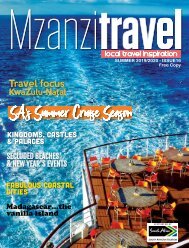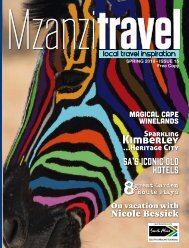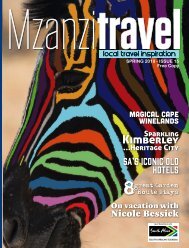MZANZI ISSUE 16
Create successful ePaper yourself
Turn your PDF publications into a flip-book with our unique Google optimized e-Paper software.
Heritage<br />
Today’s Strand Street used to be the beach, but land reclamations<br />
in the 1930s and 1940s created the Foreshore and pushed the<br />
sea back to where the harbour is today, causing the Castle to<br />
now find itself in the centre of Cape Town, far from the sea.<br />
Until the late 1800s the Castle served as the administrative<br />
seat of South Africa as well as the governor’s residence.<br />
When the governors later relocated, the Castle continued to<br />
serve as the political centre until the formation of the Union<br />
of South Africa in 1910. It was handed over to the South<br />
African National Defence Force in 1917, who still occupy and<br />
manage the Castle today. In 1936, the Castle was declared<br />
a National Monument.<br />
No visit to Cape Town is complete without taking a guided<br />
tour of the Castle. Cutting across the central courtyard is<br />
the building known as De Kat which housed the residences<br />
of the governor and the secunde (second-in-command), and<br />
a large council hall that also served as a church. It is from<br />
the perfectly preserved, ornate balcony of De Kat designed<br />
by Louis Michel Thibault and with reliefs and sculptures by<br />
Anton Anreith — the entrance to the governor’s residence<br />
—that announcements and judicial sentences – including<br />
death sentences - were read to the inhabitants of the Castle.<br />
Many a drama, both happy and gut-wrenchingly miserable,<br />
played itself out here.<br />
Today, in more pleasant circumstances, De Kat houses the<br />
Iziko William Fehr Collection of historical paintings, antique<br />
furniture, and ceramics that have special relevance to the<br />
early Cape.<br />
The military history of the Castle and Cape Town is also<br />
preserved here, with the Castle Military Museum housing an<br />
impressive array of military artefacts and exhibits from the<br />
17th to the 19th centuries. Visiting the Castle one can also<br />
view the changing of the guard at noon and the Key Ceremony<br />
(replicating the ceremonial unlocking of the Castle) at 10am<br />
and noon every weekday.<br />
Other highlights of a Castle tour include a visit to a unique<br />
torture chamber or interrogation room, recently upgraded to<br />
create an even more authentic experience. Next to it is the<br />
Donker Gat (dark hole) in which prisoners, including the early<br />
Cape rebel Adam Tas, were locked up in absolute darkness.<br />
During your visit the door will be closed so you can experience<br />
just how totally dark it was.<br />
In the Castle are also statues of the amaHlubi king Langalibalele‚<br />
Zulu king Cetshwayo‚ Bapedi king Sekhukhune and the<br />
Khoisan leader Doman, all of whom were incarcerated at<br />
the Castle at different times. There is a ceramic art museum<br />
where the original sculptured lions that used to protect the<br />
main entrance, are on display. Then there is the Lady Anne<br />
Ballroom, named after Lady Anne Barnard, a Scottish travel<br />
writer, artist and socialite, and the author of the ballad Auld<br />
Robin Gray, whose five-year residence in Cape Town had a<br />
significant impact on the cultural and social life of the time.<br />
Still there too is the Dolphin Pool where Lady Anne is said to<br />
have bathed in the nude, much to the moral consternation of<br />
the authorities of the time.<br />
Then there is the memorial dedicated to the Khoi princess<br />
Krotoa, or Eva as she was called by Van Riebeeck. Eva was<br />
employed in the Van Riebeeck household as a child minder<br />
and doubled as a translator. She lived in the original Fort of<br />
Good Hope but had an association with the later Castle as<br />
well after she married a Danish soldier and explorer Pieter van<br />
Meerhof. After his death she fell apart and started drinking<br />
heavily. Eventually her children were sent to Mauritius (but<br />
later returned) and she was banished to Robben Island where<br />
she died on 29 July <strong>16</strong>74.<br />
You can also visit a bakery and kitchen to see how people<br />
made their food back then, see the officers’ living quarters, or<br />
enjoy a meal in the De Goewerneur Restaurant which serves<br />
delicious Malay, Dutch and French cuisine.<br />
But of course, while a visit to the Castle is a fascinating must,<br />
South Africa’s relationship with such august places of abode<br />
iStock-Henrique NDR Martins<br />
iStock-angipants
















